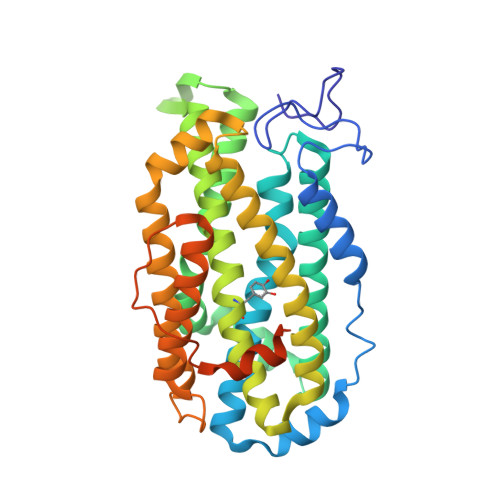Autocatalytic generation of dopa in the engineered protein R2 F208Y from Escherichia coli ribonucleotide reductase and crystal structure of the dopa-208 protein.
Aberg, A., Ormo, M., Nordlund, P., Sjoberg, B.M.(1993) Biochemistry 32: 9845-9850
- PubMed: 8373782
- DOI: https://doi.org/10.1021/bi00088a040
- Primary Citation of Related Structures:
1RNR - PubMed Abstract:
The mutant form Phe-208-->Tyr of the R2 protein of Escherichia coli ribonucleotide reductase contains an intrinsic ferric-Dopa cofactor with characteristic absorption bands at 460 and ca. 700 nm [Ormö, M., de Maré, F., Regnström, K., Aberg, A., Sahlin, M., Ling, J., Loehr, T. M., Sanders-Loehr, J., & Sjöberg, B. M. (1992) J. Biol. Chem. 267, 8711-8714]. The three-dimensional structure of the mutant protein, solved to 2.5-A resolution, shows that the Dopa is localized to residue 208 and that it is a bidentate ligand of Fe1 of the binuclear iron center of protein R2. Nascent apoR2 F208Y, lacking metal ions, can be purified from overproducing cells grown in iron-depleted medium. ApoR2 F208Y is rapidly and quantitatively converted to the Dopa-208 form in vitro by addition of ferrous iron in the presence of oxygen. Other metal ions (Cu2+, Mn2+, Co2+) known to bind to the metal site of wild-type apoR2 do not generate a Dopa in apoR2 F208Y. The autocatalytic generation of Dopa does not require the presence of a tyrosine residue at position 122, the tyrosine which in a wild-type R2 protein acquires the catalytically essential tyrosyl radical. It is proposed that generation of Dopa initially follows the suggested reaction mechanism for tyrosyl radical generation in the wild-type protein and involves a ferryl intermediate, which in the case of the mutant R2 protein oxygenates Tyr 208. This autocatalytic metal-mediated reaction in the engineered R2 F208Y protein may serve as a model for formation of covalently bound quinones in other proteins.
- Department of Molecular Biology, University of Stockholm, Sweden.
Organizational Affiliation:



















